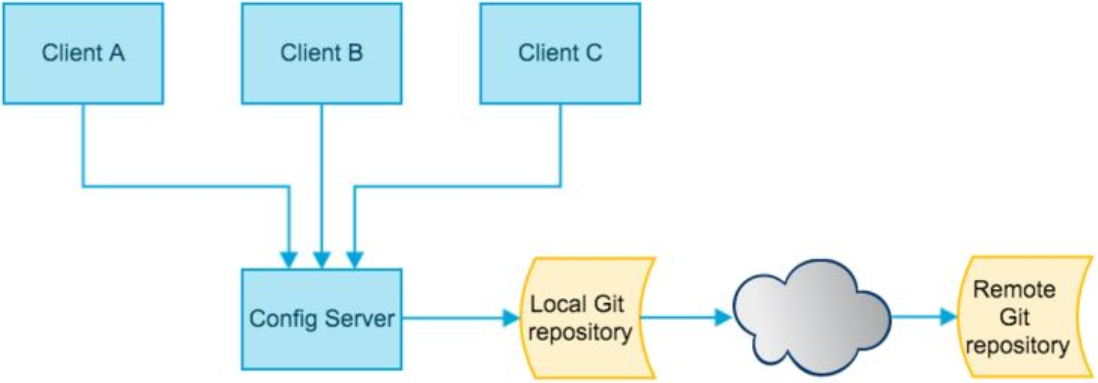Spring Cloud Config 分布式配置中心
相关链接:
- SpringCloud 微服务学习
- RESTful 接口设计规范
- SpringCloud Eureka 服务注册与发现
- SpringCloud Consul 服务注册与发现
- SpringCloud Ribbon 客户端负载均衡与服务调用
- SpringCloud OpenFeign 服务接口调用
- SpringCloud Hystrix 熔断器
- SpringCloud Gateway 服务网关
- SpringCloud Zuul 服务网关
- Spring Cloud Config 分布式配置中心
- Spring Cloud Bus 消息总线
- SpringCloud Stream 消息驱动
- SpringCloud Sleuth 分布式请求链路追踪
- SpringCloud Alibaba
- SpringCloud Alibaba Nacos服务注册和配置中心
- SpringCloud Alibaba Sentinel 实现熔断与限流
- SpringCloud Alibaba Seata 分布式事务
一、概述
微服务将原本应用中的业务拆分成一个个子服务,每个服务粒度相对较小,因此系统中会出现大量服务。每个微服务都有自己的配置信息才能运行,当微服务较多的时候,有一套集中式的、动态的配置管理组件是适宜的。
Spring Cloud 提供了 ConfigServer 来解决这个问题。
二、Config
1、基本信息
官方:https://cloud.spring.io/spring-cloud-static/spring-cloud-config/2.2.1.RELEASE/reference/html/
SpringCloud Config 为微服务架构中的各个微服务提供集中式的外部配置支持,配置服务器为各个不同微服务应用的所有环境提供了一个中心化的外部配置。
SpringCloud Config 分为服务端和客户端两个部分。
服务端也叫分布式配置中心,它是一个独立的微服务应用,用来连接配置服务器并为客户端获取配置信息,加密解密信息等访问接口。
客户端则是通过指定的配置中心来管理应用资源、以及业务相关的配置内容,并在启动的时候从配置中心获取和加载配置信息。
配置服务器默认采用git来存储配置信息,这样有助于对环境配进行版本管理,且可以通过git客户端工具来方便的管理和访问配置内容。由于SpringCloud Config默认使用Git来存储配置文件,同时也有其它方式,比如支持svn和本地文件,但官方最推荐的还是Git,而且使用的是http/https访问的形式。
服务端负责将git(svn)中存储的配置文件发布成REST接口,客户端可以从服务端REST接口获取配置。但客户端并不能主动感知到配置的变化,从而主动去获取新的配置。客户端如何去主动获取新的配置信息呢,springcloud已经给我们提供了解决方案,每个客户端通过POST方法触发各自的刷新。
2、主要特点
(1)针对不同环境不同配置,可以动态化配置更新,如多环境部署dev/test/prod/beta/release.
(2)运行期间动态调整配置,可以不需要在每个服务部署机器上编写配置文件,服务会向配置中心统一拉取自己的配置信息。
(3)当配置发生变动时,服务无须重启即可感知配置变化并应有新的配置。
(4)Config将配置信息以REST接口形式暴露
(5)默认使用git 存储,与github整合。
三、Config 使用
1、Config 配置-Git
1.1 服务端配置
(1)准备工作
登录github账号,在Github上新建一个名为sprincloud-config的新Repository 。
在本地硬盘上新建git仓库并clone刚刚的仓库,地址:D:\springcloud2020。
git clone git@github.com/username/sprincloud-config.git在D:\springcloud2020\sprincloud-config目录新建多环境的配置文件,注意文件格式为UTF-8
config-dev.yml
config-prod.yml
config-test.yml
config-dev.yml 的内容:
config:
info: this is master config-dev from github ---config-test.yml 的内容:
config:
info: this is master config-test from github ---config-prod.yml 的内容:
config:
info: this is master config-prod from github ---如果需要修改可以模拟运维人员修改配置文件,进行提交。
git add .
git commit -m "init yml"
git push origin master新建子工程cloud-config-2255,作为cloud的配置中心模块。
(2)引入pom依赖
<!-- config server -->
<dependency>
<groupId>org.springframework.cloud</groupId>
<artifactId>spring-cloud-config-server</artifactId>
</dependency>
<dependency>
<groupId>org.springframework.cloud</groupId>
<artifactId>spring-cloud-starter-netflix-eureka-client</artifactId>
</dependency>
<dependency>
<groupId>org.springframework.boot</groupId>
<artifactId>spring-boot-starter-web</artifactId>
</dependency>
<dependency>
<groupId>org.springframework.boot</groupId>
<artifactId>spring-boot-starter-actuator</artifactId>
</dependency>(3)YML配置
server:
port: 2255
spring:
application:
name: cloud-config-center
cloud:
config:
server:
git:
uri: 填写你自己的github路径
search-paths:
- springcloud-config
label: master
eureka:
client:
service-url:
defaultZone: http://localhost:7001/eureka
(4)启用Config服务
在主启动类上使用注解@EnableConfigServer
package com.xiaocai.springcloud;
import org.springframework.boot.SpringApplication;
import org.springframework.boot.autoconfigure.SpringBootApplication;
import org.springframework.cloud.config.server.EnableConfigServer;
@SpringBootApplication
@EnableConfigServer
public class ConfigCenterMain2255 {
public static void main(String[] args) {
SpringApplication.run(ConfigCenterMain2255 .class,args);
}
}写个访问的controller
package com.xiaocai.springcloud.Controller;
import org.springframework.beans.factory.annotation.Value;
import org.springframework.web.bind.annotation.GetMapping;
import org.springframework.web.bind.annotation.RestController;
@RestController
public class ConfigClientController {
@Value("${config.info}")
private String configInfo;
@GetMapping("/configInfo")
public String getConfigInfo(){
return configInfo;
}
}(5)测试
注意:host 添加域名
127.0.0.1 config-2255.com启动服务,访问测试:http://config-2255.com:2255/master/config-dev.yml
浏览器是否打印出config-dev.yml的内容。
(6)配置读取规则
官方列举:
http服务支持的格式
/{application}/{profile}[/{label}]
/{application}-{profile}.yml
/{label}/{application}-{profile}.yml
/{application}-{profile}.properties
/{label}/{application}-{profile}.properties推荐使用格式:
/{label}/{application}-{profile}.yml
/{label}/{application}-{profile}.properties
label 只的github 仓库里的分支
master分支:
http://config-2255.com:2255/master/config-dev.yml
http://config-2255.com:2255/master/config-test.yml
http://config-2255.com:2255/master/config-prod.yml
dev分支:
http://config-2255.com:2255/dev/config-dev.yml
http://config-2255.com:2255/dev/config-test.yml
http://config-2255.com:2255/dev/config-prod.yml
小结:
/{label}/{application}-{profile}.yml
- label :分支
- application :服务名
- profiles: 环境(dev/test/prod)
1.2 客户端配置
客户端工程是除Config Server 之外的其他微服务。
新建子工程 cloud-config-client-2266
(1)引入pom依赖
<dependency>
<groupId>org.springframework.cloud</groupId>
<artifactId>spring-cloud-starter-config</artifactId>
</dependency>
<dependency>
<groupId>org.springframework.cloud</groupId>
<artifactId>spring-cloud-starter-netflix-eureka-client</artifactId>
</dependency>(2)新建bootstrap.yml配置
application.yml 是用户级的资源配置项;
bootstrap.yml是系统级的资源配置项,优先级更高。
Spring Cloud 会创建一个 Bootstrap Context ,作为spring 应用的 Application Context 的父上下文。初始化时,Bootstrap Context 负责从外部源加载配置属性并解析配置。这两个上下文共享一个从外部获取的 Envitonment 。
bootstrap 属性有更高的优先级,默认情况下不会被本地配置覆盖。Bootstrap Context 和 Application Context 有着不同的约定,所以新增了一个bootstrap.yml文件,保证 Bootstrap Context 和 Application Context配置的分离。
server:
port: 2266
spring:
application:
name: config-client
cloud:
config:
label: master # /{label}/{name}-{profile}.yml
name: config # /{label}/{name}-{profile}.yml
profile: dev # /{label}/{name}-{profile}.yml
uri: http://localhost:2255 # 配置中心地址
eureka:
client:
service-url:
defaultZone: http://eureka7001.com:7001/eureka
spring.cloud.config.label 、spring.cloud.config.name 、spring.cloud.config.profile 三个值会按照/{label}/{name}-{profile}.yml的格式组合成要读取的配置文件名。
(3)启用类和访问地址
启用类
package com.xiaocai.springcloud;
import org.springframework.boot.SpringApplication;
import org.springframework.boot.autoconfigure.SpringBootApplication;
import org.springframework.cloud.config.server.EnableConfigServer;
@SpringBootApplication
@EnableConfigServer
public class ConfigClient_2266 {
public static void main(String[] args) {
SpringApplication.run(ConfigClient_2266.class,args);
}
}访问地址
package com.xiaocai.springcloud.Controller;
import org.springframework.beans.factory.annotation.Value;
import org.springframework.web.bind.annotation.GetMapping;
import org.springframework.web.bind.annotation.RestController;
@RestController
public class ConfigClientController {
@Value("${config.info}")
private String configInfo;
@GetMapping("/configInfo")
public String getConfigInfo(){
return configInfo;
}
}(4)测试
(A)修改本地仓库配置文件
修改本地硬盘上git仓库里的文件: config-dev.yml 配置并提交到GitHub中,比如加个变量xiaocai 或者版本号version=1.2
config-dev.yml 的内容:
config:
info: this is master config-dev from github --- version=1.2 --- xiaocai test
(B)启动两个工程测试
启动config server 进行自测
访问1:http://config-2255.com:2255/master/config-dev.yml
访问2:http://config-2255.com:2255/master/config-test.yml
启动confi client ,测试访问:http://localhost:2266/configInfo 看是否能获取修改后的最新配置。
工程不要停止,再次修改config-dev.yml 的内容:
config:
info: this is master config-dev from github --- version=1.3 --- xiaocai dev
提交到github远程仓库。
重新访问Config Server:http://config-2255.com:2255/master/config-dev.yml 会发现配置中心的配置立即更新了。
重新访问Config Client:http://localhost:2266/configInfo 会发现配置没有更新。
重启Config Client 之后,再次访问 http://localhost:2266/configInfo 配置才会更新。
(4)Config Client 动态刷新
在客户端工程 cloud-config-client-2266 引入监控模块:
<dependency>
<groupId>org.springframework.boot</groupId>
<artifactId>spring-boot-starter-actuator</artifactId>
</dependency>修改YML配置:
server:
port: 2266
spring:
application:
name: config-client
cloud:
config:
label: master # /{label}/{name}-{profile}.yml
name: config # /{label}/{name}-{profile}.yml
profile: dev # /{label}/{name}-{profile}.yml
uri: http://localhost:2255 # 配置中心地址
eureka:
client:
service-url:
defaultZone: http://eureka7001.com:7001/eureka
## 暴露健康端点,此处使用 *
management:
endpoints:
web:
exposure:
include: "*"
添加注解@RefreshScope :
package com.xiaocai.springcloud.Controller;
import org.springframework.beans.factory.annotation.Value;
import org.springframework.cloud.context.config.annotation.RefreshScope;
import org.springframework.web.bind.annotation.GetMapping;
import org.springframework.web.bind.annotation.RestController;
@RefreshScope
@RestController
public class ConfigClientController {
@Value("${config.info}")
private String configInfo;
@GetMapping("/configInfo")
public String getConfigInfo(){
return configInfo;
}
}测试操作:
启动config server 进行自测
访问1:http://config-2255.com:2255/master/config-dev.yml
启动config client ,测试访问:http://localhost:2266/configInfo 查看
工程不要停止,再次修改config-dev.yml 的内容:
config:
info: this is master config-dev from github --- version=1.4 --- xiaocai dev22
提交到github远程仓库。
重新访问Config Server:http://config-2255.com:2255/master/config-dev.yml 会发现配置中心的配置立即更新了。
此时手工发送post请求刷新端口为2266的config client工程,执行命令:
curl -X POST "http://localhost:2266/actuator/refresh"( windows 需要自己安装curl 命令)
重新访问Config Client:http://localhost:2266/configInfo 会发现配置更新。
工程不要停止,再次修改config-dev.yml 的内容反复以上操作进行测试验证。
2、Config 配置-SVN
2.1 服务端
(1)准备工作
电脑安装一下下 SVN Server,官方下载地址:https://www.visualsvn.com/server/download/
在SVN Server 中新建一个仓库 sprincloud-config
创建一个 config 目录。
在本地硬盘上创建一个SVN检出的文件夹 D:\springcloud-svn
在目录进行SVN检出操作,SVN地址:https://DESKTOP-77P2ES4/svn/sprincloud-config/config
创建三个配置文件:
- config-dev.properties
- config-prod.properties
- config-test.properties
特别说明:properties 格式或 yml格式都可以,最好和工程里的配置文件格式一致。
config-dev.properties的内容:
config.info=this is trunk config-dev from svn server ---config-test.properties的内容:
config.info=this is trunk config-test from svn server ---config-prod.properties 的内容:
config.info=this is trunk config-prod from svn server ---并提交到SVN仓库。
创建子工程 Config-SVN-2277
(2)引入依赖
<dependency>
<groupId>org.springframework.boot</groupId>
<artifactId>spring-boot-starter-web</artifactId>
</dependency>
<dependency>
<groupId>org.springframework.cloud</groupId>
<artifactId>spring-cloud-config-server</artifactId>
</dependency>
<!-- https://mvnrepository.com/artifact/org.tmatesoft.svnkit/svnkit -->
<dependency>
<groupId>org.tmatesoft.svnkit</groupId>
<artifactId>svnkit</artifactId>
<version>1.9.3</version>
</dependency>注意:这里引入了 svnkit 的依赖。
(3)配置文件
server.port=8003
spring.application.name=config-svn-2277
spring.cloud.config.server.svn.uri=https://DESKTOP-77P2ES4/svn/sprincloud-config/config
spring.cloud.config.server.svn.search-paths=
spring.cloud.config.server.svn.username=xiaocai
spring.cloud.config.server.svn.password=123456
spring.profiles.active=subversion
spring.cloud.config.server.default-label=注意:如果svn地址中有主分支标记 trunk,那么default-label=trunk,和git的相似。
(4)启用config 服务
使用@EnableConfigServer注解激活即可。
package com.xiaocai.springcloud;
import org.springframework.boot.SpringApplication;
import org.springframework.boot.autoconfigure.SpringBootApplication;
import org.springframework.cloud.config.server.EnableConfigServer;
@SpringBootApplication
@EnableConfigServer
public class ConfigSVNApp_2277 {
public static void main(String[] args) {
SpringApplication.run(ConfigSVNApp_2277 .class,args);
}
}(5)测试
启动工程,访问:http://localhost:2277/config-dev.properties
2.2 客户端
新建子工程 cloud-config-client-2288
(1)引入pom依赖
<dependency>
<groupId>org.springframework.cloud</groupId>
<artifactId>spring-cloud-starter-config</artifactId>
</dependency>
<dependency>
<groupId>org.springframework.boot</groupId>
<artifactId>spring-boot-starter-actuator</artifactId>
</dependency>(2)2个配置文件
需要配置两个配置文件,application.properties和bootstrap.properties
application.properties如下:
spring.application.name=spring-cloud-config-client
server.port=2288bootstrap.properties如下:
spring.cloud.config.name=config
spring.cloud.config.profile=dev
#配置中心地址
spring.cloud.config.uri=http://localhost:2277/
spring.cloud.config.label=master
# 开启端点暴露
management.endpoints.web.exposure.include=*- spring.application.name:对应{application}部分
- spring.cloud.config.profile:对应{profile}部分
- spring.cloud.config.label:对应git的分支。如果配置中心使用的是本地存储,则该参数无用
- spring.cloud.config.uri:配置中心的具体地址
- spring.cloud.config.discovery.service-id:指定配置中心的service-id,便于扩展为高可用配置集群。
特别注意:上面这些与spring-cloud相关的属性必须配置在bootstrap.properties中,config部分内容才能被正确加载。因为config的相关配置会先于application.properties,而bootstrap.properties的加载也是先于application.properties。 bootstrap.properties和bootstrap.yml 相同,只是文件格式不一样。
(3)controller
@RefreshScope注解开启自动刷新,在客户端执行/refresh的时候就会更新此类下面的变量值 :
package com.xiaocai.springcloud.Controller;
import org.springframework.beans.factory.annotation.Value;
import org.springframework.web.bind.annotation.GetMapping;
import org.springframework.web.bind.annotation.RestController;
@RefreshScope
@RestController
public class ConfigSVNClientController {
@Value("${config.info}")
private String configInfo;
@GetMapping("/configInfo")
public String getConfigInfo(){
return configInfo;
}
}(4)测试
启动config svn 配置中心进行自测
访问1:http://config-2277.com:2277/config-dev.properties (如果这种不行就写个controller访问)
启动config client ,测试访问:http://localhost:2288/configInfo 查看
工程不要停止,修改config-dev.properties 的内容:
config.info=this is master config-dev from github --- version=S1.2 --- 提交到SVN仓库。
重新访问Config Server:http://config-2277.com:2277/config-dev.properties 会发现配置中心的配置立即更新了。
此时手工发送post请求刷新端口为2288的config client工程,执行命令:
curl -X POST "http://localhost:2288/actuator/refresh"( windows 需要自己安装curl 命令)
重新访问Config Client:http://localhost:2277/config-dev.properties会发现配置更新。
工程不要停止,再次修改config-dev.properties的内容反复以上操作进行测试验证。
以post请求的方式来访问http://localhost:2288/configInfo 就会更新修改后的配置文件。
四、Config 其他
后续学习再补充。







